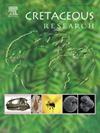A new armored crocodyliform from the Upper Cretaceous of Catalonia (Spain): new insight into the evolution of the eusuchian postcranial and dermal skeleton
IF 1.7
3区 地球科学
Q1 GEOLOGY
引用次数: 0
Abstract
The origin and early radiation of Crocodylia have shifted attention to the Upper Cretaceous of Europe, where numerous new taxa have recently been discovered. Particularly abundant are the remains associated with allodaposuchids, a controversial and recently established eusuchian clade whose postcranial record is rarely documented. Here, we describe a new allodaposuchid specimen from the Fontllonga-6 fossil locality (Àger Basin, NE Spain) in the Fontllonga Group (lower upper Maastrichtian). The specimen consists of cranial, postcranial, and dermal skeleton remains, making it the most complete crocodyliform from the Upper Cretaceous of Europe. It exhibits massive vertebrae and a large ribcage, while the numerous recovered osteoderms show diverse morphologies, providing insight into their position within the dermal skeleton. It presents peculiar teeth ornamentation only observed in Allodaposuchus palustris in the Ibero-Armorican domain. However, confident taxonomic assignment remains challenging due to the lack of other diagnostic traits. Including anatomical information provided by the specimen in phylogenetic analyses underscores the significance of postcranial characters in reconstructing relationships within Eusuchia. This new finding fills a data gap in the postcranial anatomy of eusuchians and allodaposuchids, offering insights into the ecology of this successful clade from the Upper Cretaceous of Europe.
西班牙加泰隆尼亚上白垩纪新发现的一种带甲鳄鱼形:对尤苏奇动物颅后和真皮骨骼进化的新认识
鳄鱼类的起源和早期辐射已经将人们的注意力转移到了欧洲的上白垩纪,在那里最近发现了许多新的分类群。特别丰富的是与异足类相关的遗骸,异足类是一个有争议的新近建立的真足类分支,其颅后记录很少被记录。在此,我们描述了来自Fontllonga群(lower upper Maastrichtian)中Fontllonga-6化石位置(Àger Basin, NE Spain)的一种新的异源类动物标本。该标本由颅骨、颅骨后和真皮骨架遗骸组成,使其成为欧洲上白垩纪最完整的鳄鱼形。它展示了巨大的椎骨和巨大的胸腔,而许多恢复的骨皮显示出不同的形态,提供了对它们在真皮骨骼中的位置的见解。它具有独特的牙齿纹饰,仅在伊比利亚-阿莫里亚地区的Allodaposuchus palustris中观察到。然而,由于缺乏其他诊断特征,自信的分类分配仍然具有挑战性。在系统发育分析中包含标本提供的解剖学信息,强调了颅后特征在重建乌苏奇动物关系中的重要性。这一新发现填补了真足类和异足类后颅解剖学的数据空白,为了解这一来自欧洲上白垩纪的成功进化分支的生态学提供了新的见解。
本文章由计算机程序翻译,如有差异,请以英文原文为准。
求助全文
约1分钟内获得全文
求助全文
来源期刊

Cretaceous Research
地学-地质学
CiteScore
4.10
自引率
19.00%
发文量
235
审稿时长
12 weeks
期刊介绍:
Cretaceous Research provides a forum for the rapid publication of research on all aspects of the Cretaceous Period, including its boundaries with the Jurassic and Palaeogene. Authoritative papers reporting detailed investigations of Cretaceous stratigraphy and palaeontology, studies of regional geology, and reviews of recently published books are complemented by short communications of significant new findings.
Papers submitted to Cretaceous Research should place the research in a broad context, with emphasis placed towards our better understanding of the Cretaceous, that are therefore of interest to the diverse, international readership of the journal. Full length papers that focus solely on a local theme or area will not be accepted for publication; authors of short communications are encouraged to discuss how their findings are of relevance to the Cretaceous on a broad scale.
Research Areas include:
• Regional geology
• Stratigraphy and palaeontology
• Palaeobiology
• Palaeobiogeography
• Palaeoceanography
• Palaeoclimatology
• Evolutionary Palaeoecology
• Geochronology
• Global events.
 求助内容:
求助内容: 应助结果提醒方式:
应助结果提醒方式:


